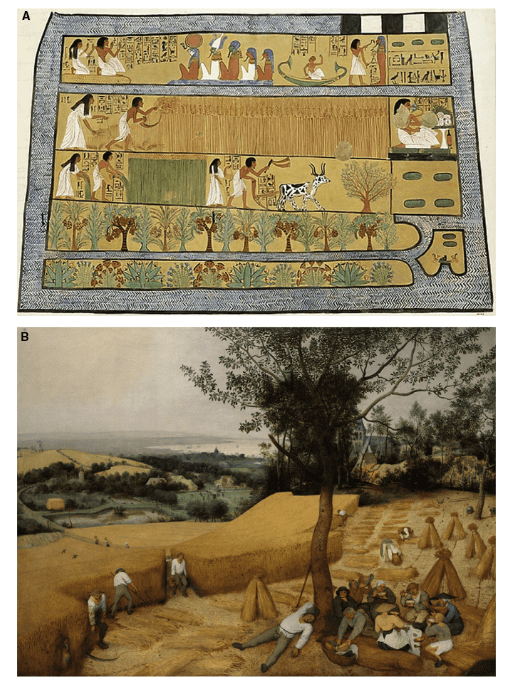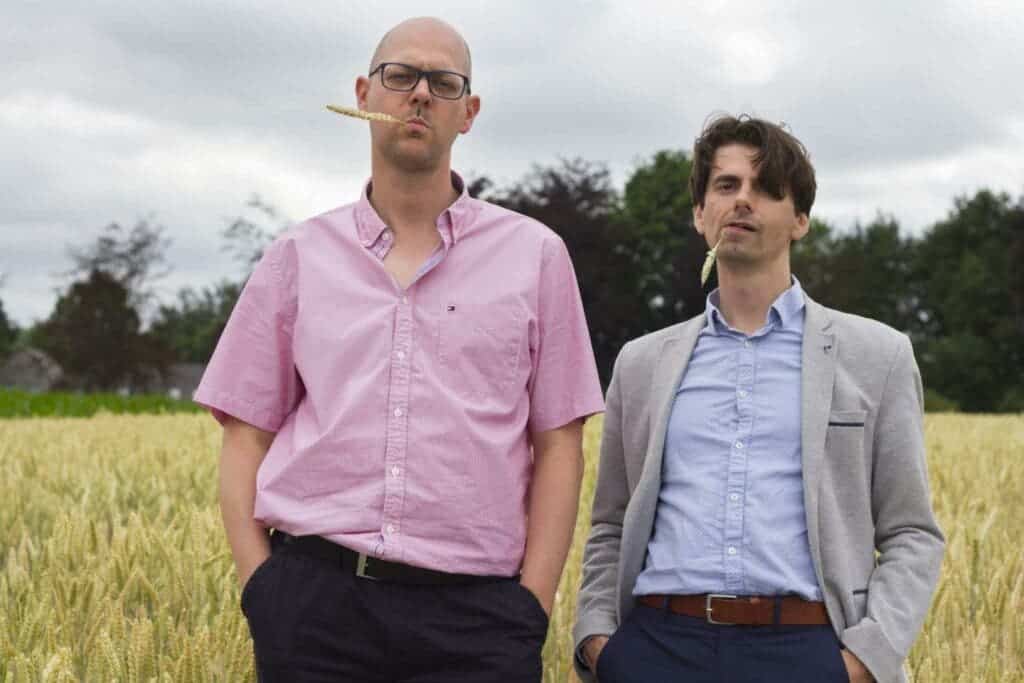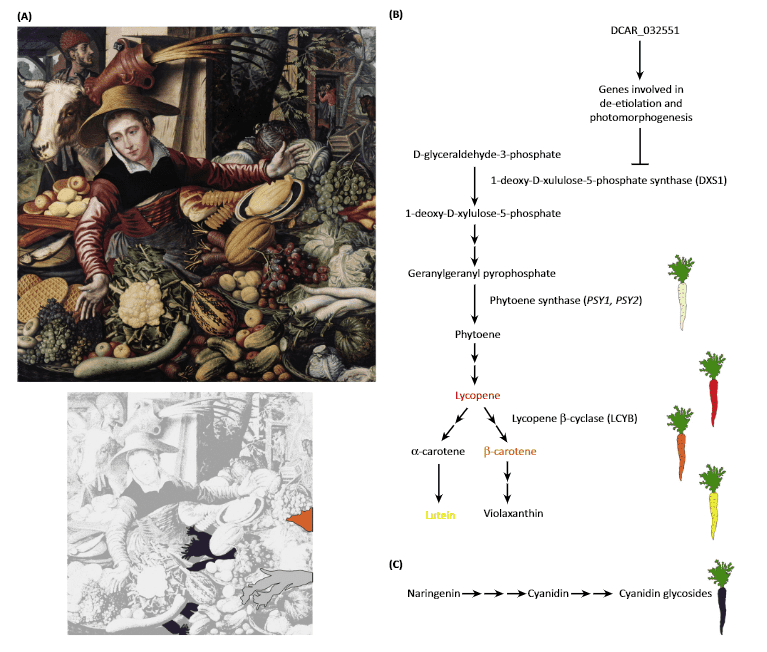
BCE). (B) The Harvesters by Pieter Bruegel the Elder, 1565.
For years, biologists have been tapping into the genomes of both modern and ancient crops in order to trace their long and rich history — from wild plains to your dinner table. However, there are still significant gaps in the timeline of both fruit and vegetable evolution, despite the availability of sophisticated genetic sequencing technology.
An unlikely pair of researchers are now seeking to address these gaps using a unique approach. In a new study, Ive De Smet, a plant biologist at the VIB-UGent Center for Plant Systems Biology in Belgium, and David Vergauwen, an art history lecturer at Amarant in Belgium, demonstrate how old paintings can be highly useful in tracking how fruit and veggies evolved across the last centuries.
Are you intrigued? If so, you’re not alone. In fact, you’re encouraged to lend a hand as the two researchers are looking to the public to extend a helping hand by providing pictures of paintings that depict plant-based food.
Evolution hidden in art

If you were to travel back in time ten thousand years, you would have been in for a big surprise. Virtually, all the succulent fruits and savory vegetables we all dearly love looked nothing like they do today. In fact, it took countless generations of selective breeding to turn measly wild plants into highly productive food crops. For instance, modern corn is 1,000 times larger and contains at least four times more sugar than the wild variety that used to grow on the plains of Mexico ten thousand years ago.
Sometimes these transitions are obvious, but other times the jigsaw puzzle is more challenging to piece together, which is why biologists are grateful for any input they can find — so why should art be an exception?
For De Smet and Vergauwen, who have been friends for 30 years since high school, this uncanny union is not at all as esoteric as it may sound. Their foray into the intersection between art and evolutionary biology first began during an unsuspecting trip to the Hermitage Museum in Saint-Petersburg.
“A couple of years back, we were in Saint-Petersburg (Russia). At the Hermitage we started a discussion about the fruits depicted by Frans Snyders. The question was: did this particular piece of fruit look like this in the 17th century or was Snyders a bad painter? It was well worth the discussion, since the next day, on the train to Tsarkoe Selo, we started to wonder if there were other fruits or vegetables that had similar stories behind them. Years later, we are still investigating. It turned out to be a valuable (and hardly used) approach to combine our expertise on the level of (art) history and genetics. Maybe there are not that many art historians who have biologists as their best friend and the other way around?” De Smet told ZME Science in an email.
Intrigued by the ideas they were discussing back and forth, the two researchers scoured the available literature for any work that combines art history and genetics. They hit a blank wall.
“So, we started to do some digging and I guess we’ve never stopped digging. Some friends play tennis together or go fishing. Ive and David visit museums, meet other scholars, look at paintings and study the history of our modern foods,” De Smet recounted.
Content that they found a niche, the two researchers set to work right away looking for clues that might inform them what fruits and vegetables looked like in the past.
For example, their investigations of ancient Egyptian depictions of watermelons showed that the fruit had the familiar light and dark green stripes even during those times.
In conjunction with the DNA sequencing of a watermelon leaf retrieved from an Egyptian tomb, this suggests that the fruit was domesticated as early as 4,000 years ago. But despite its similar appearance to modern varieties, this ancestral strain was similar in taste to cucumbers, predating sweet melons by thousands of years, according to a 2019 paper authored by De Smet and Vergauwen.
Be on the lookout for paintings depicting plants
Although old artwork can provide valuable clues as to how plants used to look centuries ago, or even before their domestication, such assessments aren’t at all straightforward.
Painters often depict the world with an artistic license, which makes their artwork unreliable as an accurate reflection of the world. Even some modern painters can’t be trusted. For instance, if you trust Picasso to depict a watermelon as it really looks, you’ll surely be in for a surprise. This is why expertise in art history is essential.
“How do we know a painting is reliable? If you look at a cubist work by Picasso to figure out what a pear looked like in the early 20th century, you will be disappointed. That is where art history comes in. Some paintings are reliable in only some aspects, some are totally reliable and others not at all, like the Picasso. The works by Jeroen Bosch might show a morphologically correct depiction of a strawberry, but it might be taller than the people next to it. It would be fanciful to suppose that there were indeed any such large strawberries, but if the strawberry is morphologically correct, we might draw conclusions from that,” De Smet told ZME Science.
“So how do we know what to believe? That is a matter of trusting the evidence. If a painter depicts clothes correctly and we can verify that with specimens from a museum or other paintings, if a painter depicts musical instruments (violins or harpsichords) that are still in a museum and they match up, if a painter depicts architecture that is still around (say the central market place of Antwerp) and it checks out, then we do not have a reason to suppose that we would go about his work in a totally different way when it comes to perishables like fruits and vegetables. It is a simple question of checking the reliability of your source and trusting the evidence. And often it is also a matter of numbers. If something is depicted only once it might be an oddity (or a poor-quality painter), but if something pops up regularly it might indeed be how it (at least in part) looked like.”
This is why De Smet and Vergauwen hope to inspire people to participate in a citizen science project by supplying pictures of paintings depicting fruits and vegetables.
“We can only travel so much, so this is one of the reasons why we started this Crowd Sourcing campaign, the tap into resources we would normally not be able to,” said De Smet.
“We cannot be everywhere. Sure, we have visited the Hermitage, the Louvre, the National Gallery in London, etc., but if an interesting 17th-century tomato is depicted in the kitchen of a Spanish monastery that is almost never open to visitors, we run the risk of never finding out about that. That is why we need help. We want to find as much material as possible. Catalogues are of no help, because a mythological painting with Perseus freeing Andromeda can have a perfectly fine orange in the background, but the description, the title or a small picture of that painting will never give us a clue of where to find it. We need people to notice it. Then we need them to report their findings. We came up with this citizen science idea quite early on in our project and we are looking at ways to finance an app to help people to help us. There is still so much to do.”
That’s not to say that old paintings can reveal instances of plant evolution that genomic analyses have missed, although this isn’t beyond the realm of plausibility. Instead, art history and genetics can join hands to construct more accurate timelines of when a particular fruit or vegetable crop enters common usage.
Take carrots, for instance. Today, the popular vegetable is ubiquitously recognized due to its orange appearance thanks to high carotenoid contents. However, 17th-century paintings from the Dutch Golden Century depict carrots in white, red, yellow, and orange. This isn’t some creative fluke — that’s really how carrots used to look when the painters were alive.

parsnip (grey). (B,C) illustrate some of the major components leading to carrot colour. The diagrams highlight the enzymes and/or major products in carotenoid (B) and anthocyanin pathways (C). Credit: Trends in Plant Science, Vergauwen and De Smet.
What’s intriguing is that this approach can be extended for virtually all instances of evolution that may have been captured by art, from plants to animals. But, for now, the two researchers are content to stick to what they know best: art history, genetics, and a passion for visiting museums.
“I guess we will never stop visiting museums. This was a hobby of ours long before we started this project. The only difference is that now we can tell our wives that we have to take a trip “for work’,” the researchers said.
So you’re an art aficionado but also a science nerd? Then drop a line to the researchers at artgeneticsdavidive@gmail.com — your help and keen eye will be surely appreciated.



